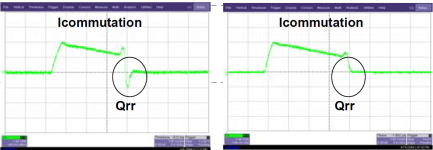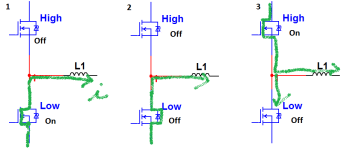Since I do not have access to the wiki, I'll share my findings here.
Setting shoot through protection is often looked upon as: "Increase dead time until power consumption goes down, and then increase this figure some - to be safe". The problem here is Qrr, or "Body diode reverse recovery charge". During dead time - the body diode will continue to supply current to the load. When the high side turns on, (this is rather hard to explain) the body diode of the low side mosfet is brutally stopped - This creates a huge spike and a lot of EMI with it.
My own experience; Reducing my dead time from 50nS to 18nS reduced TDH from 2% to 0,1%. It improved the efficiency of my controller from 92% to 94%! This was a huge source to EMI. This is one of the biggest improvements, and I wish it was the first I did. All the random noise problems was most likely much influenced from this. Qrr sets off hard switching ringing (this is a function stray inductances (layout and packages)). So, before snubbing your circuit - try adjusting your dead time. Choosing mosfets with lower Qrr could be a good way to go if that does not work.
Qrr varies with mosfet temperature, so care must be taken when optimizing dead time insertion.
Here is a bad graphic, but I hope it clears it a bit up.

Setting shoot through protection is often looked upon as: "Increase dead time until power consumption goes down, and then increase this figure some - to be safe". The problem here is Qrr, or "Body diode reverse recovery charge". During dead time - the body diode will continue to supply current to the load. When the high side turns on, (this is rather hard to explain) the body diode of the low side mosfet is brutally stopped - This creates a huge spike and a lot of EMI with it.
My own experience; Reducing my dead time from 50nS to 18nS reduced TDH from 2% to 0,1%. It improved the efficiency of my controller from 92% to 94%! This was a huge source to EMI. This is one of the biggest improvements, and I wish it was the first I did. All the random noise problems was most likely much influenced from this. Qrr sets off hard switching ringing (this is a function stray inductances (layout and packages)). So, before snubbing your circuit - try adjusting your dead time. Choosing mosfets with lower Qrr could be a good way to go if that does not work.
Qrr varies with mosfet temperature, so care must be taken when optimizing dead time insertion.
Here is a bad graphic, but I hope it clears it a bit up.



